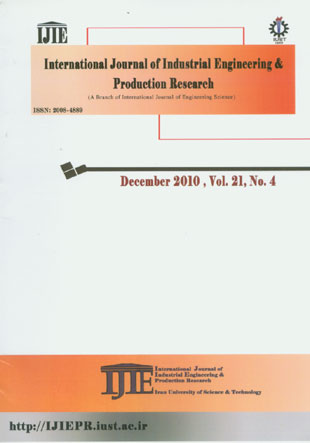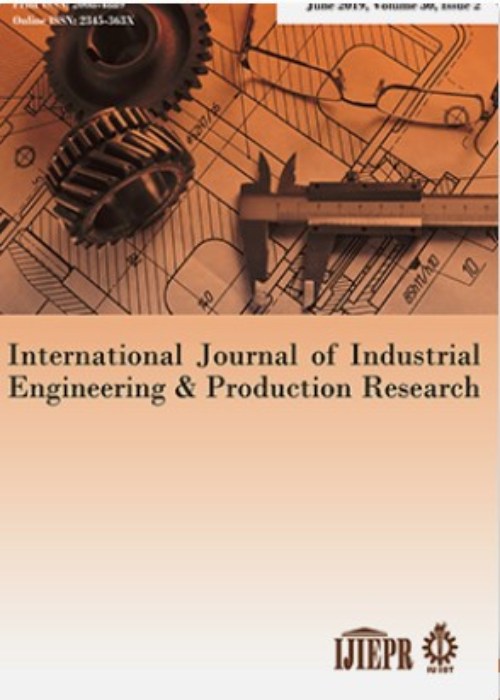فهرست مطالب

International Journal of Industrial Engineering and Productional Research
Volume:21 Issue: 4, Dec 2010
- تاریخ انتشار: 1390/03/07
- تعداد عناوین: 7
-
-
Page 173This paper aims to evaluate inventory cost of a Two-echelon serial supply chain system under vendor managed inventory program with stochastic demand, and examine the effect of environmental factors on the cost of overall system. For this purpose, we consider a two-echelon serial supply chain with a manufacturer and a retailer. Under Vendor managed inventory program, the decision on inventory levels are made by manufacturer centrally. In this paper, we assume that the manufacturer monitors inventory levels at the retailer location and replenishes retailer's stock under (r, n, q) policy; moreover, the manufacturer follows make-to-order strategy in order to respond retailer's orders. In the other word, when the inventory position at the retailer reaches reorder point, r, the manufacturer initiates production of Q=nq units with finite production rate, p. The manufacturer replenishes the retailer's stock with replenishment frequency n, and the complete batch of q units to the retailer during the production time. We develop a renewal reward model for the case of Poisson demand, and drive the mathematical formula of the long run average total inventory cost of system under VMI. Then, by using Monte Carlo simulation, we examine the effect of environmental factors on the cost of overall system under VMI.
-
Page 181Response time is one of the critical web service quality dimensions. It refers to how long it takes that a web service responds to request of a user. In order to manage the response time, pricing schemes can work as an efficient access control mechanism. In this paper, we study competition between two providers offering functionally same web services where there is a monopoly service provider. The monopoly offers a service that is complementary to their services. Each provider needs to decide a service level (L or H) and a corresponding price for the selected service level to meet the service level guarantee. We construct a Stackelberg game and benefit from queuing theory concept to propose a model that can examine strategic choices of the providers.
-
Page 197In this paper flexible job-shop scheduling problem (FJSP) is studied in the case of optimizing different contradictory objectives consisting of: (1) minimizing makespan, (2) minimizing total workload, and (3) minimizing workload of the most loaded machine. As the problem belongs to the class of NP-Hard problems, a new hybrid genetic algorithm is proposed to obtain a large set of Pareto-optimal solutions in a reasonable run time. The algorithm utilizes from a local search heuristic for improving the chance of obtaining more number of global Pareto-optimal solutions. The solution method uses from a perturbed global criterion function for guiding the search direction of the hybrid algorithm. Computational experiences show that the hybrid algorithm has superior performance in contrast to previous studies.
-
Page 211Managing products’ end-of-life and recovery of used products is gaining significant importance during last years. Therefore, managing the reverse flow of products can be an important potential for winning consumers in future competitive markets. In this context, establishing reverse logistics networks is becoming a main problem in reverse supply chains. Genetic Algorithm (GA) is utilized to solve the proposed NP-hard problem and find the best possible design for different facilities. In order to test the applicability of proposed GA, we suppose a tire reverse logistic case and solve the problem. The results show that the least cost will be achieved by using the free space of distribution centers and integrating collection and inspection centers within them. In addition, we suggest using hybrid algorithm in future allocation problems to obtain best solutions.
-
Page 221In an increasing number of practical situations, the quality of a process or product can be effectively characterized and summarized by a profile. A profile is usually a functional relationship between a response variable and one or more explanatory variables which can be modeled frequently using linear or nonlinear regression models. In this paper, we study the effect of non-normality on profile monitoring in Phase II when within or between autocorrelation is present. Different levels of autocorrelation and skewed and heavy-tailed symmetric non-normal distributions are used in our study to evaluate the performance of three existing monitoring schemes numerically. Simulation results indicate that the non-normality and autocorrelation can have a significant effect on the in-control performances of the considered schemes. Results also indicate that the out-of-control performances of the schemes are not very sensitive to low and moderate levels of autocorrelation in moderate and large shifts.
-
Page 231The problem of locating distribution centers (DCs) is one of the most important issues in design of supply chain. In previous researches on this problem, each DC could supply products for all of the customers. But in many real word problems, DCs can only supply products for customers who are in a certain distance from the facility, coverage radius. Thus, in this paper a multi-objective integer linear programming (MOILP) model is proposed to locate DCs in a two-echelon distribution system. In this problem, customers who are in the coverage radius of the DCs can be supplied. Moreover, we suppose that the coverage radius of each DC can be controlled by decision maker and it is a function of the amount of money invested on the DC. Finally, a random generated problem is used to verify the model and the computational results are presented.
-
Page 239The unprecedented growth of competition in the banking technology has raised the importance of retaining current customers and acquires new customers so that is important analyzing Customer behavior, which is base on bank databases. Analyzing bank databases for analyzing customer behavior is difficult since bank databases are multi-dimensional, comprised of monthly account records and daily transaction records. Few works have focused on analyzing of bank databases from the viewpoint of customer behavioral analyze. This study presents a new two-stage frame-work of customer behavior analysis that integrated a K-means algorithm and Apriori association rule inducer. The K-means algorithm was used to identify groups of customers based on recency, frequency, monetary behavioral scoring predicators; it also divides customers into three major profitable groups of customers. Apriori association rule inducer was used to characterize the groups of customers by creating customer profiles. Identifying customers by a customer behavior analysis model is helpful characteristics of customer and facilitates marketing strategy development.


